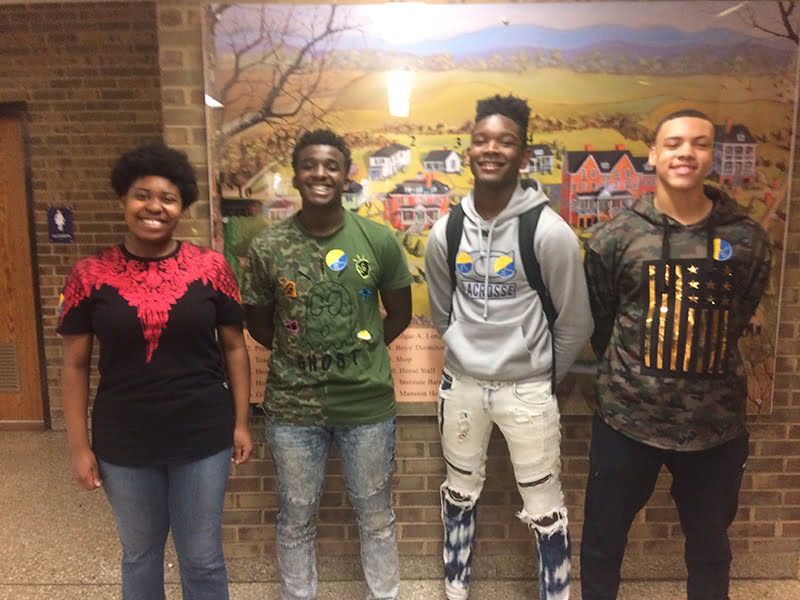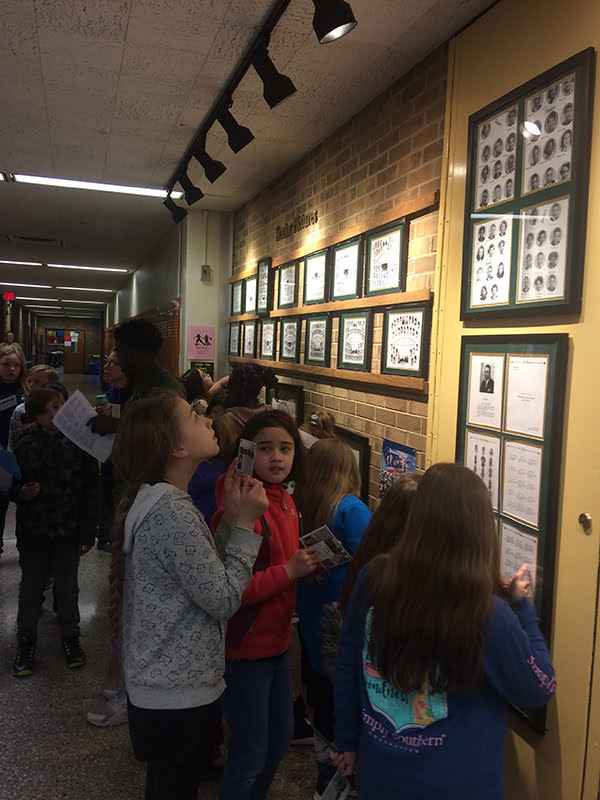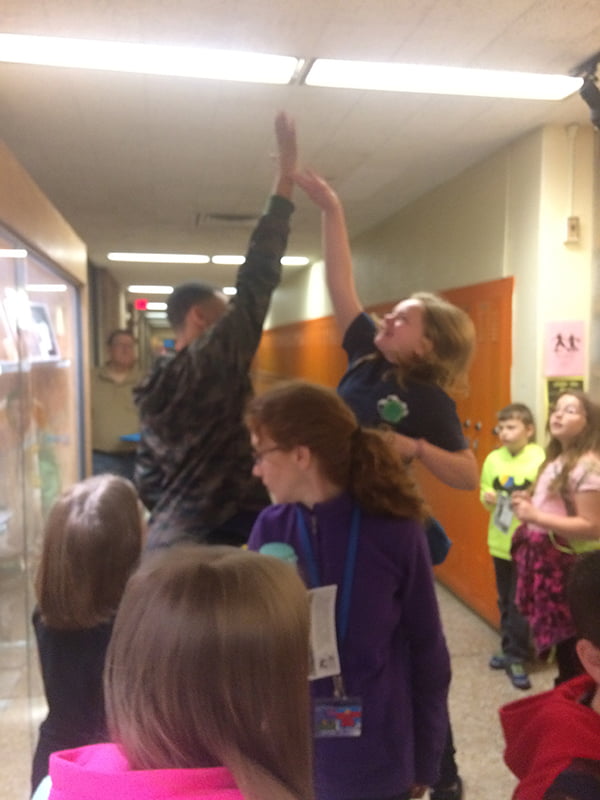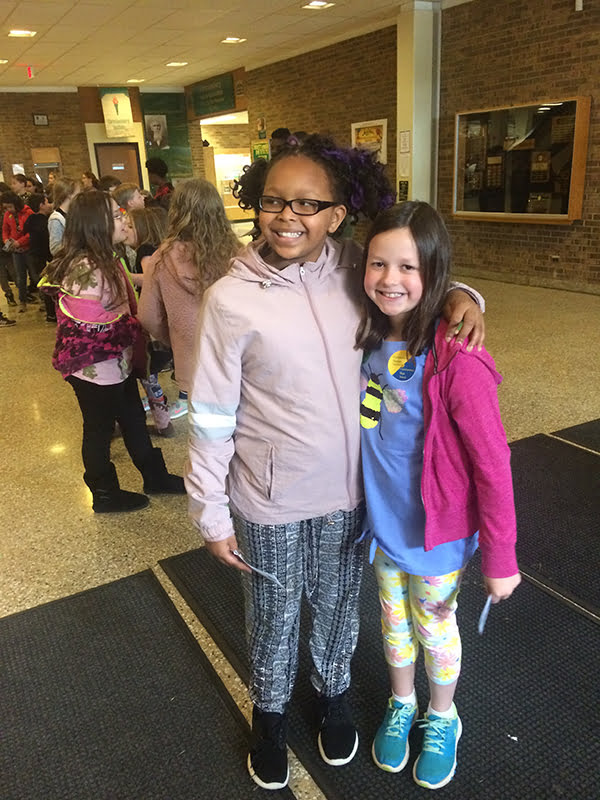
In a jostling line, thirty-two 10 year olds are in the Christiansburg High School theater waiting for their hosts, the Black Students Awareness Club to show them around. Falling Branch Elementary School fourth-grade students in Simon Johnson’s social studies class are studying the American Civil War, specifically how it manifested in Virginia.

“We’re studying post-Civil War reconstruction, civil rights and massive resistance,” said a girl in sparkly sneakers.
To understand more fully, life for African-American people in Christiansburg in the 19th and 20th centuries, last week, the fourth grade took a field trip to several local and related sites.
“We want to be sure that we represent all facets of our local history,” Superintendent Mark Miear said in an email. “We hope that this field trip is just one additional step in educating students about the history of the African-American community in our area.”
So, setting larger history in local context, the students visited the Shaeffer Baptist Church (High Street) built by Friends immediately after the war, then went to the site of the Christiansburg Institute (Scattergood Drive), and on the hill just above, to Christiansburg High School’s display of Christiansburg Institute memorabilia called CI at CHS.
Christiansburg Industrial Institute was established by the Quaker Freedman’s Bureau in 1866 in the still-smoldering ruins of Southern Reconstruction to serve newly emancipated slaves in 1866 and closed a hundred years later as part of Virginia’s obdurate desegregation in1966.
Christiansburg High School remembers Christiansburg Institute in a hall-long exhibit of local lore collected from alumni and assembled by students and volunteers. In the glass cases lining the hall to the music department, there is a1958 CI Tigers letter jackets (it was found in the main office closet), black and white photos of young men in bow ties and young women in white blouses and a mural map of the Institute’s acres of grounds and buildings that once spread out in the fields below.
Younger kids learn best from older kids, research says, and those who teach learn too. Four volunteers from the Black Student Awareness Club tall, friendly, high-fiving 15-year-olds welcomed the fourth graders leading them around the corner to the hall lined with memorabilia from the Christiansburg Institute designed to commemorate living history in Christiansburg,

Jaanai Smith, 16 and sophomore, greets the kids. “At Christiansburg High School today,” she said. “You’ll see lots of students who are different colors and speak different languages, but it used to be that black students couldn’t come here. They weren’t allowed to come here. But really that was okay, because Christiansburg Institute was a great place to learn.”
The older students hand out cards describing a CI student, they tour the exhibit looking for information about the person on their card: how old were they? what did they study?
“I think it’s a good learning experience and people are really trying to answer the questions,” nine-year-old Allyson Weir, who was looking for more information about CI student and Radford resident, Odell William Palmer.
The history of the Christiansburg Institute is so local, that some Falling Branch students are related to CI students.
“I got to learn about my great-great grandmother who passed away two years ago,” Tieara Hawks, 10 said.
Dave Dickinson, administrator for the social studies in the county was central in assembling the exhibit. He found a number of articles particularly compelling.
“Mr. Graves, the barbering instructor, we found his leather-bound grade book for students from the 1947-48 school year. I found that important because teacher’s grade books are invaluable and the fact that we found one with his signature and little notes about the students puts a personal touch on the exhibit.”
The high-schoolers and elementary school students already know each other.
“During Black History Month, we read to them. We want to do more of that,” sophomore Smith said.
Club member, freshman Jaxson Clark, 15, helped the kids move through the exhibit, handing out stickers for successful completion.

Asked about the value of bringing young people on field trips like this to the CI exhibit, he said, “The younger the better, I’d say. If they start learning about inclusivity and diversity early, it’ll be way better when they get to high school.”
Mrs. Johnson’s class stands in another jostling line to climb on the school bus to go, practically within sight, just up on High Street to the Schaffer Baptist Church. They’re all wearing blue and gold stickers that say “Christiansburg Industrial Institute 1866-1966 Gone but not Forgotten.”
Field trips are not new to these fourth graders. They go to the Native American village at Natural Bridge when they’re learning about Monacan Indians. They go bowling and to the Radford planetarium, to plays and ballets.
“We don’t just go by text books, we try to make it a full experience. As real-life as we can,” Mrs. Johnson said. Frank conversation about harsh realities of conquest and colonization provide more complete lessons about Christopher Columbus and Jamestown.
“With Jamestown and pushing Native Americans off their land. We ask, “Was that fair?” These children are more open to those questions and they’re more apt to listen and incorporate those lessons into their lives.”



